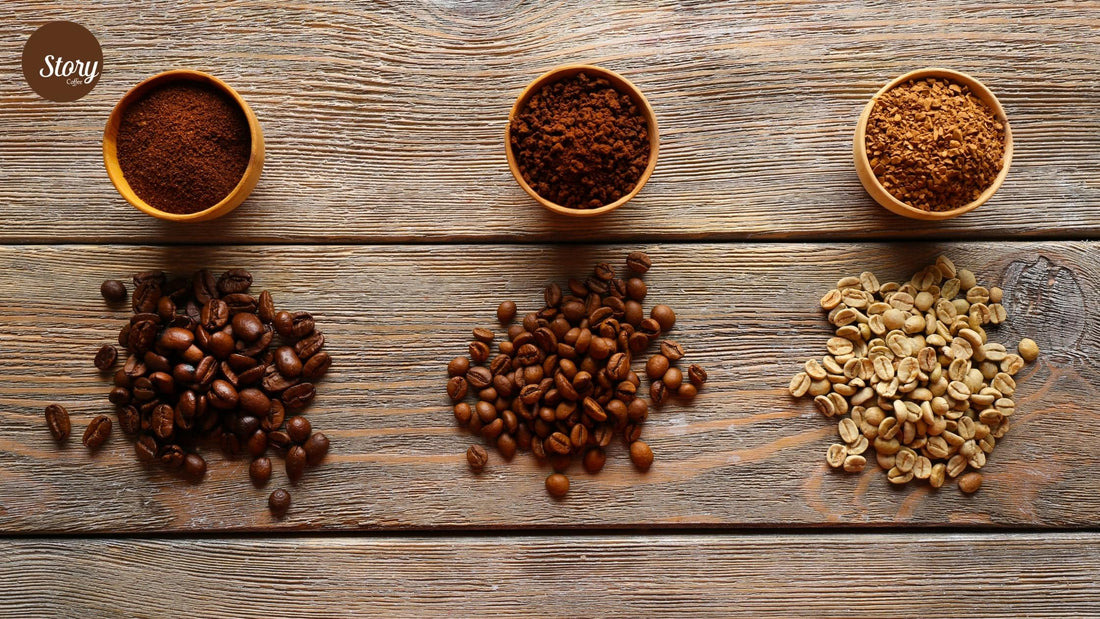Delving in a warm and delicious cup of coffee is surely a treat. However, there is more to your coffee than meets the eye! Whichever part of the world or country your coffee beans are from , there’s goes a huge processing behind it that involved steps like plantation, harvesting, handpicking, sorting, sun drying, polishing, roasting and others.
This happens before your coffee is sold to you in either of the two broad branches – whole bean coffee or ground coffee i.e. powdered coffee.
For a better understating of our drink we need to clearly know the difference between these two major classifications of coffee.
A whole bean coffee is exactly what it claims to say in the name. It is not grounded or shredded.
The entire bean is received intact by the customer after having been picked, dried, polished, roasted and tailored.
Needless to say that you cannot consume or brew your cup of coffee with beans. Hence, this bean is for consumers who have coffee grinders/ coffee makers at home for a ‘from scratch’ beverage creation.
Ground coffee on the other hand is the opposite of whole bean coffee because the grinding part has already been pre worked upon to just have a powdered version of the drink so that it can be easily mixed with any fluid of your choice.
The major similarity between the two are that whether or not they have been grounded up or kept in tact, all of them have to be roasted and prepared to be consumed, they cannot be in a green coffee state.
Green coffee is coffee cherry in its initial forms: unroasted, unpolished, raw and not hardened.
To understand the difference a whole bean coffee and a ground coffee bean can make… we need to know more about coffee beans because your warm cup of coffee is the result of nothing but good coffee beans mixed and polished to make fine coffee powder or whole.
To begin with the first thing that comes to our mind is…
How long does it take for a coffee bean to form?
The coffee plant takes 3 to 4 years of good growth in favorable conditions. These include lower temperatures below 30 degree Celsius, heavy water flow etc. to grow and bear its first fruit. These are coffee cherries, crimson red in color.
This can be consumed as food too! These cherries have the seed inside them which are then taken out and processed to make those brown chocolate beans.
The difference is made at the core of these beans. This is by distinctions like place of origin, roasting intensity, size and other factors.
So these factors will add to distinguished results in ground and whole bean coffee. What also acts as influencing factor is the type of coffee bean taken .
Apart from the many sub divisions, coffee beans is of 2 main types and 2 or 3 surrounding types. The surrounding types are Liberica, Excelsa, Geisha.
Liberica is the largest in size, irregular and much harder to find. It has a much lower yield.
Excelsa, very close to the Liberican family is usually found in South East Asia.
Geisha or Gesha is another newly found branch of coffee that originated in the Ethiopian regions mostly.
Other rare types include bourbon, typica etc.
These branches are however not as much in demand as the two branches of coffee. These are all over the world and especially in India- Coffee Robusta and Coffee Arabica.
Robusta coffee is the second most produced coffee type in the world. It grows at certainly elevated areas and is known to have a strong, acidic and rubbery taste. The caffeine content is around 2.7%.
And Arabica coffee is the most produced coffee in the world with the highest demands all around. It is finer and milder in taste with lower caffeine content of around 1.5% which ensures a smoother finish.
Now, it is only obvious that all these factors add up to create different results in hole bean and ground coffee.
Every roastery tries to have a tilting side on making whole bean coffee for their customers. This is because it is a known fact that whole bean coffee will, at any point, be effectively tasteful. Ground coffee is most easily wanted however.
This is because the moment we break down the beans we start losing nutritional and mineral elements from it.
The more artisanal your coffee is, the lesser the chances of losing its original taste. The whole bean coffee has almost lost nothing except the extra moisture it had as green coffee before being roasted.
It has the oils and minerals in a much higher quantity than grounded beans. Also, as we grind coffee beans, it starts evaporating its oils which stay locked in a whole bean. This effects the entire flavour palette frequency of your coffee.
Another important separating factor is expiration limits of the two. Whole beans do not lost most of their minerals and oils which are ocked in. This is why they have a much higher shelf life than grounded coffee, which tends to last much shorter.
Speaking about flavors, it is not entirely true that grounded coffee loses its flavours. Instead of that, a well packed and sealed grounded coffee can yield results for a long time. When storage conditions are instructed, they are actually given for the benefit of the consumers.
Staleness in coffee is a result of oxidization which both whole bean and grounded coffee will eventually become. The stagnancy of grounded coffee in dry conditions helps settling the flavors.
At present the Indian region of Coorg is a sensation in the coffee plantation world. Karnataka’s Coorg is known as the coffee center of India for the famous production of Arabica and Robusta.
We know most of the premium Indian artisanal coffees are derived from here. Whole beans as well as grounded coffee are extremely prevalent in Indian consumers.
We cannot deny that the ease of getting ground coffee all ready to be filtered into a warm and rich cup of coffee is alluring. It is certainly an able alternative to generically engineered instant coffees and powders.
However, whole beans too have their own regal share of rich aroma and flavors packed in them. All you need is a good coffee grinder.

